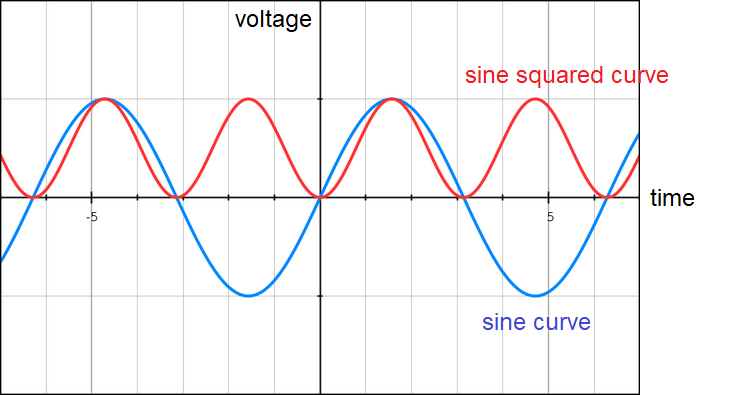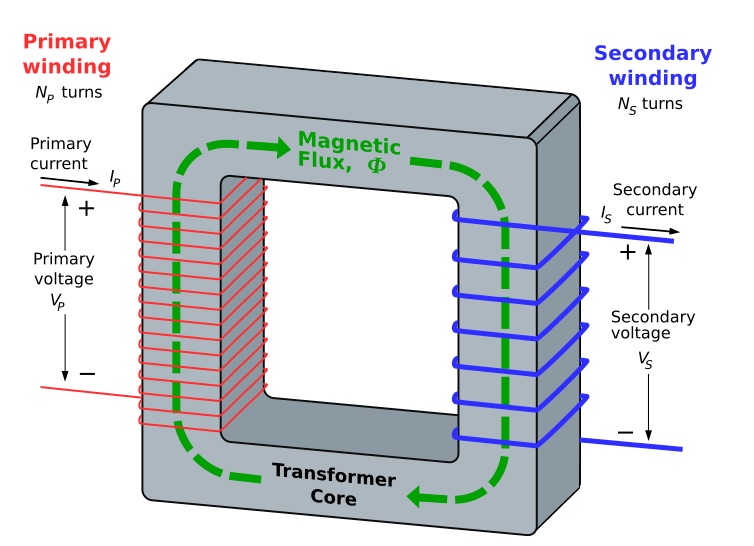
There are two basic types of electric current that we have in everyday life - direct current (DC), and alternting current (AC).
DC is the type of current we get if we connect a battery to a light bulb. It is an electric current that flows only in one direction.
AC, on the other hand, is an electric current that keeps changing direction.
DC tends to be more familiar, as battery is quite common and many children might have played with them and learnt a bit about them in their first science lessons.
AC, on the other hand, is the most common type of electricity we use in everyday life - when we switch on the light at home, use the computer, the refrigerator, washing machine, ...
So it is interesting that msot people know lot less about the physics of AC than the physics of DC. And why does it have to keep changing direction anyway ??
There can be a few answers. For example, the immediate output of an electricity generator is an alternating current. In case you wonder, batteries are not suitable for producing the huge amount of electricity needed everyday for towns and cities.
But I think the most important answer is to to save energy. How can alternating energy save more energy that direct current? The answer lies in something called called transformer.
No, not the movie Transformer where a car transforms into a robot - but a device that changes a low voltage electricity to a high voltage one, or vice versa. I shall give an idea of how this works below.
First, we need to know a bit more about alternating current, or alternating voltage. As explained in my previous article, and an alternating voltage is a voltage that keeps changing direction. And the reason why it keeps changing direction is because of the way that an electricity generator is built. You may ask why the electricity generator cannot be built to give direct current - or current that goes in one direction. Actually, it can be quite easily modified to this. The reason for using alternating current is actually to save energy.
But why does alternating current save energy?? Read on. You will find the answer below.
FIrst, lets look at what alternating voltage from a simple generator look like. It looks like the blue curve - labelled "sine curve".

The reason it has this smooth wave shape is because of the way it is generated - by rotating a coil of wire in a magnetic field. If we replace the normal electicity generator with a flipping battery, then it would look like repeating squares.
The common alternating voltage in the figure above can be described by this equation:
where
- V is the voltage that comes out of the generator at a time t,
- V0 is the maximum voltage of the voltage as it changes repeated in time, and
- ω is 2π / period of rotation of the coil.
If you have not learnt trigonometry, or you are not a fan of it, then just think of the voltage as smoothly increasing, decreasing, changing direction, and doing this repeatedly. Like what the image above hopes to show.
The electric current that can flow out of this generator
where I is the current coming out at time t, and I0 is the maximum current.
Lets think about say a simple filament light bulb connected to an alternating current (a.c.) power supply. The filament in the light bulb has a resistance. This gets so hot when electric current flows that it starts glowing.
An alternating current increases and decreases repeatedly. This means that the power of the light bulb also increases and decreases repeatedly.
This usually happens around 50 times per second, too fast for our eyes to notice. So what our eyes see is brightness from an averaged power of the light bulb.
So what fraction is the averaged power compared to the peak power from the a.c. power supply? We can actually tell quite easily from the graph above.
In the graph, the peaks and troughs are symmetrical. The energy from the light bulb is equal to the area under the graph - see my article on physics syllabus on mathematics required - second last graph.
To find the average, refer to the graph above. We can take the areas of the top half of the "sine squared curve", and fill up the troughs next to them. Then we get a straight line that runs through the center - at half the height of the original peaks!
So we get a simple answer : the mean power in a resistive load is half the maximum (peak) power for a sinusoidal alternating current. This is the answer to a common exam question!
The current keeps changing direction, and has the same magnitude in both directions. If we think of this direction mathematically - like one direction is positive and the other direction is negative - then the average current of an alternating is actually zero.
But it is useful to know what is the DC current - the fixed, same direction current - that can give the same average power as the alternating current.
To find this, we recall one of the graphs in the article on physics syllabus on mathematics required : area under a power-time graph is energy. The idea then is this:
1. Sketch a current-time graph for an AC. Since the graph is repeating, we just need to look at one cycle.
2. Sketch the power-time graph using P = I^2 R. Note power us related to square of the current.
3. We can see - by eye - from this graph is symmetrical about the half way line.
So mean power is half the peak power.
What is the unchanging DC current that give the same power? This is a convenient number to know because the correponding power is the same as the AC mean power.
We know from P = I2 R that power is related to current squared. So half the peak power would mean current divided by square root of 2:
The above steps can sound a bit complicated if you see this for the first time. But to summarise, this quantity I_rms stands for root-mean-square current. It literally means "the root of the mean of the square of the current".
If you are confused, don't worry. Students usually get to know this after some exercises.
We are now ready to look at why alternating current saves energy. It is because an alternating current can be easily converted to one with a much higher voltage and much lower current. This can be done using a device called a transformer.
But why does this save energy. Because of the much lower current, the loss of energy due to heating of electric cable resistance would also be a lot less.
So how does the transformer work ?
Short answer : by combining the last 2 topics - electromagnetism and electromagnetic induction.
The simple version of a transformer consists of an soft iron loop, and 2 coils of wires like this:

This is how it works:
1. An alternating voltage is applied to the coil on the left. Lets call this primary voltage.
2. A magnetic field is produced through the iron core, and follows the core through the secondary coil on the right.
3. This magnetic field keeps changing since the current in the coil keeps alternating, so it induces a voltage in the secondary coil. Lets call this the secondary voltage.
That is basically it! So what is the use of this?
And the answer is - if we change the number of turns in the secondary coil, the flux linkage changes, and the voltage output can change.
So starting with one voltage at the primary coil, we can use the transformer to create a different voltage at the secondary coil !
Today, this is likely built in to many electric plugs we use for our electronic devices. But an early and important use is for sending electricity over long distances, for example from power station to our homes.
Why do we need transformer for that? What is wrong with connecting the electricity generator to our home directly with electric cables?
The answer is quite simple - electric cables are made from copper which are very good conductors of electricity. Still, the very small resistance it has can some electrical energy to be converted to heat and lost to the surrounding.
Since
when the transformer changes the the alternating current to a much higher voltage, the current would also become much smaller.
And since heating of the wire resistance happens at the rate current squared times resistance (I2 R), reducing the current means that the loss of power to heating of the cables is reduced a lot.
Use of diode to convert AC to DC
The high voltage used to transmit electricity over long distances can be tens of thousands of volts. Just before it enters our homes, it has to be converted to about 100 to 200 V by a transformer stationed nearby. In Singapore or the UK, it may be about 240 V. In the USA, it is about 100 V.
240 V is still very high for the common electronic appliances. For example, a smart phone may have to charged using a voltage of under 10 V, with a direct current (DC). So even if a transformer converts the 240 V to 9 V, it still cannot be used to charge the smart phone.
We not only need a transformer something that can convert the 240 V AC from the mains socket to about 9 V AC, but we also need something that can convert this to a DC (direct current).
An this is where an electronic component called a diode comes in. It is a device that allows electric current to flow in one direction, but not the other.
So all we need is to insert one in the circuit. It would allow current through each time it flows in the right direction, but block it when it goes in the opposite direction. Simple!

This is called a "half wave rectifier". But there is a catch - the current is blocked half the time. This is not efficient for the device we want to use. But the scientists are clever. They also came up with a circuit to re-route the reverse current back in the right direction, like this.

This is called a "full wave rectifier". So that solved the problem!
You can learn these concepts and more at Dr Hock's maths and physics tuition.